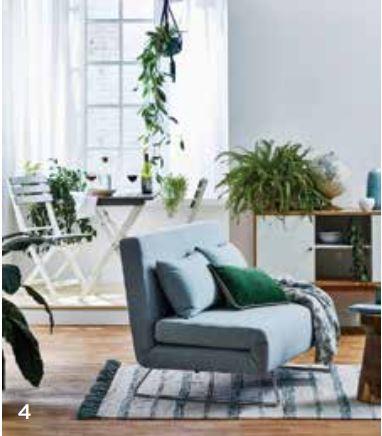
So how do you make your lessthan-large living area feel comfortably spacious?
We consulted the experts. Here’s what they had to say
1. Only keep the essentials
We’re all guilty of holding onto unnecessary stuff, so if your living room is feeling tight, it’s time to rid yourself of the junk.
Just make sure the room still reflects ‘you’ – as you’ll be the one living there.
2. Avoid bulky pieces
No matter how much you love that chunky Chesterfield, look to slimline pieces to furnish the space.
“Thanks to Scandinavian design, slim, mid-century furniture design is on trend,” says Ross Clayton, founder of Vast Furniture and Homewares. “Use those athletic lines to keep it airy.”
3. Measure twice before you buy
Remember, when it comes to furniture, it always looks smaller in the showroom. It’s a common mistake to buy furniture that’s too big for a space. People will try and squeeze in an eight-person dining table into a tiny apartment.
“If in doubt use the old cardboard mock-up on the floor,” Clayton says. “It’s really about being honest with yourself and the limitations of the room.”
4. Go for symmetry
Fact: A balanced room is technically more beautiful and is, therefore, more sympathetic to smaller spaces.
Try placing a lamp and a plant stand of similar heights on either side of the room, a lounge in between, cushions on either side of the lounge and a rug in the middle.
You don’t want it to look like a showroom, but this can be a good place to start before you add flavour with more decorative pieces.

5. Choose white & light
Chapter one of home decorating 101: Paint all the walls white and only use light timber. The space will feel instantly smaller, says Clayton.
“Or, you can buck the trend, throw out the gauntlet and bring on the light pastel!”
Cherie Barber, the founder of Renovating for Profit, says dark and warm colours advance, whereas light and cool colours recede.
“That means a dark colour will tend to close in a small space, especially if it gets no natural light,” Barber says.
“It doesn’t mean you have to go for stark, clinical white. Any light neutral colour will help make a space look bigger.”

6. Easy does it
Small rooms feel a lot smaller when you can’t access them easily.
you can’t access them easily. “Creating obstructions or a clumsy flow of traffic is a sure way to throw away valuable space,” Barber says.
“Don’t forget the space a swinging door can take up, so think about sliding or cantilevered door.”
7. Go surround with your sound
Small rooms have awesome acoustics, so introduce hidden Bluetooth speakers that don’t take up any space.
“Music adds that extra dimension to create a sanctuary,” Clayton says. “The smaller the room, the better. Surround sound can create a feeling of space.”
8. Add a picture rail… and pictures
Any opportunity to draw the eye upwards will detract from the size of the room.
“Try hanging a picture or painting of an outdoor landscape – a panoramic beach or bush shot can trick the eye into thinking about faraway places,” Clayton says.
9. Invisible(-ish) furniture
Lightweight and durable, rattan furniture is easy to shift around the room – and thanks to baby boomer trend forecasters, it’s cool again.
Best of all though, it’s partially invisible in a room.
Clayton explains: “For very small rooms, nothing beats rattan furniture. Because it’s not upholstered, you can see right through it. In the furniture game we call it 80% air.”
10. Multi-purpose furniture
Choose furniture that serves more than one purpose for small living spaces. For instance a bench seat where you can pull the top off and you’ve got a nice hideaway space
11. Mirror, mirror
Another tried-and-tested method to make a room appear larger is to fool the eye with mirrors.
“Play around with full-length mirrors,” suggests Bellef. “Try a freestanding mirror that leans against the wall to elongate the height of the room, too.”
12. Try feature lighting
Again, focus on drawing the eye upward with feature lighting.
A pendant light, for example, can force people’s attention away from eye-level and give a real sense of the entire room.
13. Less but bigger
Guess what? Big is not always bad in a small room.
“It’s good to have compact furniture but it’s more important to scale it down. One big couch will work better than two smaller couches,” Bellef says.
The same goes for artwork. “One large piece of art will make a bigger statement in a small space.”
1 – Editing your collections will help you claim back some space. Picture: Denise Braki
2 – Decorate with low contrast colour palettes. Picture: Denise Braki
3- Light and low is the way to go. Picture : Vast Furniture and Homewares
4 – Multi-purpose furniture earns its position in your living room by working overtime. Picture: Denise Braki.
5 – Why stop at mirrors? Try mirrored furniture. Picture: Natalie Hunfalvay
